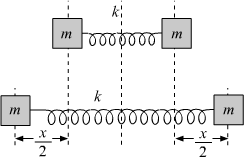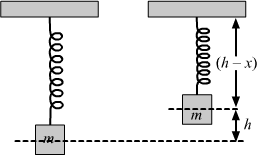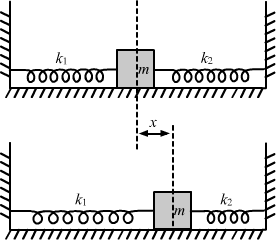HC Verma Physics books are the most preferred books among students of CBSE schools. Students can be found referring to the chapters as well as practice questions at the end of each of these chapters, in the books. Students follow these textbooks religiously since quite a few questions in these also appear in exams.
Contents
- 1 HC Verma Solutions for Class 11 Physics – Part 1: Chapter 8 Work and Energy
- 1.0.1 Page No 130:
- 1.0.2 Question 1:
- 1.0.3 Answer:
- 1.0.4 Question 2:
- 1.0.5 Answer:
- 1.0.6 Question 3:
- 1.0.7 Answer:
- 1.0.8 Question 4:
- 1.0.9 Answer:
- 1.0.10 Question 5:
- 1.0.11 Answer:
- 1.0.12 Question 6:
- 1.0.13 Answer:
- 1.0.14 Question 7:
- 1.0.15 Answer:
- 1.0.16 Question 8:
- 1.0.17 Answer:
- 1.0.18 Question 9:
- 1.0.19 Answer:
- 1.0.20 Question 10:
- 1.0.21 Answer:
- 1.0.22 Question 11:
- 1.0.23 Answer:
- 1.0.24 Question 12:
- 1.0.25 Answer:
- 1.0.26 Page No 131:
- 1.0.27 Question 13:
- 1.0.28 Answer:
- 1.0.29 Question 14:
- 1.0.30 Answer:
- 1.0.31 Question 15:
- 1.0.32 Answer:
- 1.0.33 Question 16:
- 1.0.34 Answer:
- 1.0.35 Question 17:
- 1.0.36 Answer:
- 1.0.37 Question 1:
- 1.0.38 Answer:
- 1.0.39 Question 2:
- 1.0.40 Answer:
- 1.0.41 Question 3:
- 1.0.42 Answer:
- 1.0.43 Question 4:
- 1.0.44 Answer:
- 1.0.45 Question 5:
- 1.0.46 Answer:
- 1.0.47 Question 6:
- 1.0.48 Answer:
- 1.0.49 Question 7:
- 1.0.50 Answer:
- 1.0.51 Question 8:
- 1.0.52 Answer:
- 1.0.53 Question 9:
- 1.0.54 Answer:
- 1.0.55 Question 10:
- 1.0.56 Answer:
- 1.0.57 Question 1:
- 1.0.58 Answer:
- 1.0.59 Question 2:
- 1.0.60 Answer:
- 1.0.61 Page No 132:
- 1.0.62 Question 3:
- 1.0.63 Answer:
- 1.0.64 Question 4:
- 1.0.65 Answer:
- 1.0.66 Question 5:
- 1.0.67 Answer:
- 1.0.68 Question 6:
- 1.0.69 Answer:
- 1.0.70 Question 7:
- 1.0.71 Answer:
- 1.0.72 Question 8:
- 1.0.73 Answer:
- 1.0.74 Question 9:
- 1.0.75 Answer:
- 1.0.76 Question 10:
- 1.0.77 Answer:
- 1.0.78 Question 1:
- 1.0.79 Answer:
- 1.0.80 Question 2:
- 1.0.81 Answer:
- 1.0.82 Question 3:
- 1.0.83 Answer:
- 1.0.84 Question 4:
- 1.0.85 Answer:
- 1.0.86 Question 5:
- 1.0.87 Answer:
- 1.0.88 Question 6:
- 1.0.89 Answer:
- 1.0.90 Question 7:
- 1.0.91 Answer:
- 1.0.92 Page No 133:
- 1.0.93 Question 8:
- 1.0.94 Answer:
- 1.0.95 Question 9:
- 1.0.96 Answer:
- 1.0.97 Question 10:
- 1.0.98 Answer:
- 1.0.99 Question 11:
- 1.0.100 Answer:
- 1.0.101 Question 12:
- 1.0.102 Answer:
- 1.0.103 Question 13:
- 1.0.104 Answer:
- 1.0.105 Question 14:
- 1.0.106 Answer:
- 1.0.107 Question 15:
- 1.0.108 Answer:
- 1.0.109 Question 16:
- 1.0.110 Answer:
- 1.0.111 Question 17:
- 1.0.112 Answer:
- 1.0.113 Question 18:
- 1.0.114 Answer:
- 1.0.115 Question 19:
- 1.0.116 Answer:
- 1.0.117 Question 20:
- 1.0.118 Answer:
- 1.0.119 Question 21:
- 1.0.120 Answer:
- 1.0.121 Question 22:
- 1.0.122 Answer:
- 1.0.123 Question 23:
- 1.0.124 Answer:
- 1.0.125 Question 24:
- 1.0.126 Answer:
- 1.0.127 Question 25:
- 1.0.128 Answer:
- 1.0.129 Question 26:
- 1.0.130 Answer:
- 1.0.131 Question 27:
- 1.0.132 Answer:
- 1.0.133 Page No 134:
- 1.0.134 Question 28:
- 1.0.135 Answer:
- 1.0.136 Question 29:
- 1.0.137 Answer:
- 1.0.138 Question 30:
- 1.0.139 Answer:
- 1.0.140 Question 31:
- 1.0.141 Answer:
- 1.0.142 Question 32:
- 1.0.143 Answer:
- 1.0.144 Question 33:
- 1.0.145 Answer:
- 1.0.146 Question 34:
- 1.0.147 Answer:
- 1.0.148 Question 35:
- 1.0.149 Answer:
- 1.0.150 Question 36:
- 1.0.151 Answer:
- 1.0.152 Question 37:
- 1.0.153 Answer:
- 1.0.154 Question 38:
- 1.0.155 Answer:
- 1.0.156 Question 39:
- 1.0.157 Answer:
- 1.0.158 Question 40:
- 1.0.159 Answer:
- 1.0.160 Page No 135:
- 1.0.161 Question 41:
- 1.0.162 Answer:
- 1.0.163 Question 42:
- 1.0.164 Answer:
- 1.0.165 Question 43:
- 1.0.166 Answer:
- 1.0.167 Question 44:
- 1.0.168 Answer:
- 1.0.169 Question 45:
- 1.0.170 Answer:
- 1.0.171 Question 46:
- 1.0.172 Answer:
- 1.0.173 Question 47:
- 1.0.174 Answer:
- 1.0.175 Question 48:
- 1.0.176 Answer:
- 1.0.177 Question 49:
- 1.0.178 Answer:
- 1.0.179 Question 50:
- 1.0.180 Answer:
- 1.0.181 Page No 136:
- 1.0.182 Question 51:
- 1.0.183 Answer:
- 1.0.184 Question 52:
- 1.0.185 Answer:
- 1.0.186 Question 53:
- 1.0.187 Answer:
- 1.0.188 Question 54:
- 1.0.189 Answer:
- 1.0.190 Question 55:
- 1.0.191 Answer:
- 1.0.192 Question 56:
- 1.0.193 Answer:
- 1.0.194 Question 57:
- 1.0.195 Answer:
- 1.0.196 Question 58:
- 1.0.197 Answer:
- 1.0.198 Question 59:
- 1.0.199 Answer:
- 1.0.200 Question 60:
- 1.0.201 Answer:
- 1.0.202 Question 61:
- 1.0.203 Answer:
- 1.0.204 Page No 137:
- 1.0.205 Question 62:
- 1.0.206 Answer:
- 1.0.207 Question 63:
- 1.0.208 Answer:
- 1.0.209 Question 64:
- 1.0.210 Answer:
- 2 Chapterwise HC Verma Solutions Class 11 Physics :
- 3 About the Author – HC Verma
HC Verma Solutions for Class 11 Physics – Part 1: Chapter 8 Work and Energy
For such popular books, students can get extremely helpful practice material online. For all the questions in the HC Verma books, there are several sources where students can get detailed solutions and solve their doubts and queries.
Please note that these solutions are provided here for free.
Page No 130:
Question 1:
When you lift a box from the floor and put it on an almirah the potential energy of the box increases, but there is no change in its kinetic energy. Is it a violation of conservation of energy?
Answer:
No. Work done in lifting the box increases the potential energy of the box. During lifting at every point, the force applied by us on the box in the upward direction is equal to the gravitational force acting on the box in the downward direction. Therefore, there is no change in the velocity of the box. As a result, the kinetic energy of the box will not change.
Question 2:
A particle is released from the top of an incline of height h. Does the kinetic energy of the particle at the bottom of the incline depend on the angle of incline? Do you need any more information to answer this question in Yes or No?
Answer:
No, the kinetic energy of the particle at the bottom of the inclined plane does not depend on the angle of inclination. When the particle reaches the ground, all its potential energy, while at the top of the inclined plane, is converted into kinetic energy. As we know that kinetic energy depends only on the height of the particle, it will be the same for different angles of inclination.
No, we do not need any other information to answer this question.
Question 3:
Can the work by kinetic friction on an object be positive? Zero?
Answer:
Yes. Let us consider a block A which is resting on another block B. Block B is resting on a smooth horizontal surface. Let the coefficient of friction between the blocks be
μ.

When a force F is applied on block B in the forward direction as shown in the above figure, block A moves with block B in the direction of the applied force. The frictional force on block A and the displacement will be in the forward direction. Therefore, work done by the frictional force is positive.
If we consider the reference frame of block B, then displacement of block A will be zero. Therefore, work done by the frictional force is zero.
Question 4:
Can static friction do nonzero work on an object? If yes, give an example. If no, give reason.
Answer:
Yes. Let us consider a block A which is resting on another block B. Block B is resting on a smooth horizontal surface. Let the coefficient of kinetic friction between the blocks be
μk.

When a force F is applied on block B in the forward direction as shown in the above figure, block A moves with block B in the direction of the applied force. The friction force on block A and the displacement will be in the forward direction. Therefore, work done by the friction force is positive. In this case, block A will remain in contact with block B. This shows that static friction is doing a nonzero work on an object.
Question 5:
Can normal force do nonzero work on an object? If yes, give an example. If no, give reason.
Answer:
Yes. Let us consider an elevator accelerating upward with a body placed in it. In this case, the normal reaction offered by the floor of the elevator on the body is greater than the weight of the body acting in the downward direction. If a person is observing this from the ground, then, for him, the normal reaction is doing a positive work, as the elevator is moving upward.
Question 6:
Can kinetic energy of a system be increased without applying any external force on the system?
Answer:
Yes. Let us consider an isolated system of two particles falling towards each other under their mutual gravitational force of attraction. Here, the net force on the system is zero, but the velocities of the particles keep on increasing. Also, the kinetic energy of the system is increased without applying any external force on it.
Question 7:
Is work-energy theorem valid in non-inertial frames?
Answer:
In an non-inertial frame, pseudo force also comes into account. As we know that pseudo force does not exist, work-energy theorem is not valid in non-inertial frames.
Question 8:
A heavy box is kept on a smooth inclined plane and is pushed up by a force F acting parallel to the plane. Does the work done by the force F as the box goes from A to B depend on how fast the box was moving at A and B? Does the work by the force of gravity depend on this?
Answer:
(i) No. As the surface is smooth and the friction is zero, work done by the force will only depend on the force and the displacement.
(ii) No, because gravitational force is a conservative force and work done by a conservative force will depend only on the force and the displacement.
Question 9:
One person says that the potential energy of a particular book kept in an almirah is 20 J and the other says it is 30 J. One of them necessarily wrong?
Answer:
No, both are correct. We measure potential energy from a reference level chosen by the observer. Therefore, in this case, both observers are measuring the potential energy from different reference levels.
Question 10:
A book is lifted from the floor and is kept in an almirah. One person says that the potential energy of the book is increased by 20 J and the other says it is increased by 30 J. Is one of them necessarily wrong?
Answer:
Yes, one of them is necessarily wrong. We measure potential energy from a reference level chosen by the observer. However, the change in potential energy of a body does not depend on the level of reference.
Question 11:
In one of the exercises to strengthen the wrist and fingers, a person squeezes and releases a soft rubber ball. Is the work done on the ball positive, negative or zero during compression? During expansion?
Answer:
(i) During compression, the work done on the ball is positive as the direction of the force applied by the fingers is along the compression of the ball.
(ii) During expansion, the work done is negative as expansion takes place against the force applied by the fingers on the ball.
Question 12:
In tug of war, the team that exerts a larger tangential force on the ground wins. Consider the period in which a team is dragging the opposite team by applying a larger tangential force on the ground. List which of the following works are positive, which are negative and which are zero?
(a) work by the winning team on the losing team
(b) work by the losing team on the winning team
(c) work by the ground on the winning team
(d) work by the ground on the losing team
(e) total external work on the two teams.
Answer:
(a) Work by the winning team on the losing team is positive, as the displacement of the losing team is along the force applied by the winning team.
(b) Work by the losing team on the winning team is negative, as the displacement of the winning team is opposite to the force applied by losing team.
(c) Work by the ground on the winning team is positive.
(d) Work by the ground on the losing team is negative.
(e) Total external work on the two teams is positive.
Page No 131:
Question 13:
When an apple falls from a tree what happens to its gravitational potential energy just as it reaches the ground? After it strikes the ground?
Answer:
When an apple falls from a tree, its gravitational potential energy decreases as it reaches the ground. After it strikes the ground, its potential energy will remain unchanged.
Question 14:
When you push your bicycle up on an inclined plane, the potential energy of the bicycle and yourself increases. Where does this energy come from?
Answer:
When a person pushes his bicycle up on an inclined plane, the potential energies of the bicycle and the person increase because moving up on the inclined plane the kinetic energy decreases. and as mechanical energy is sum of kinetic energy and potential energy, and remains constant for a conservative system. Therefore, potential energy must increase in this case.
Question 15:
The magnetic force on a charged particle is always perpendicular to its velocity. Can the magnetic force change the velocity of the particles? Speed of the particle?
Answer:
The magnetic force on a charged particle is always perpendicular to its velocity. Therefore, the work done by the magnetic force on the charged particle is zero. Here, the kinetic energy and speed of the particle remain unaffected, while the velocity changes due to the change in direction of its motion.
Question 16:
A ball is given a speed v on a rough horizontal surface. The ball travels through a distance l on the surface and stops. (a) what are the initial and final kinetic energies of the ball? (b) What is the work done by the kinetic friction?
Answer:
(a)
Initial kinetic energy of the ball,
Ki=12mv2Here, m is the mass of the ball.
The final kinetic of the ball is zero.
(b)
Work done by the kinetic friction is equal to the change in kinetic energy of the ball.
∴ Work done by the kinetic friction =
Kf-Ki=0-12mv2 =
-12mv2
Question 17:
Consider the situation of the previous question from a frame moving with a speed v0 parallel to the initial velocity of the block. (a) What are the initial and final kinetic energies? (b) What is the work done by the kinetic friction?
Answer:
The relative velocity of the ball w.r.t. the moving frame is given by
vr=v-v0.
(a) Initial kinetic energy of the ball =
12mvr2=12m(v-v0)2Also, final kinetic energy of the ball =
12m(0-v0)2=12mv02(b) Work done by the kinetic friction = final kinetic energy
-initial kinetic energy
=
12m(v0)2-12m(v-v0)2 =
-12mv2+mvv0
Question 1:
A heavy stone is thrown from a cliff of height h with a speed v. The stoen will hit the ground with maximum speed if it is thrown
(a) vertically downward
(b) vertically upward
(c) horizontally
(d) the speed does not depend on the initial direction.
Answer:
(d) the speed does not depend on the initial direction
As the stone falls under the gravitational force, which is a conservative force, the total energy of the stone remains the same at every point during its motion.
From the conservation of energy, we have:
Initial energy of the stone = final energy of the stone
i.e., (K.E.)i+(P.E.)i=(K.E.)f+(P.E.)f
⇒12mv2+mgh=12m(vmax)2⇒vmax=v2+2ghFrom the above expression, we can say that the maximum speed with which stone hits the ground does not depend on the initial direction.
Question 2:
Two springs A and B(kA = 2kB) are stretched by applying forces of equal magnitudes a the four ends. If the energy stored in A is E, that in B isA
(a) E/2
(b) 2E
(c) E
(d) E/4
Answer:
(b) 2E
Let xA and xB be the extensions produced in springs A and B, respectively.
Restoring force on spring A,
F=kAxA …(i)
Restoring force on spring B,
F=kBxB …(ii)
From (i) and (ii), we get:
kAxA=kBxBIt is given that kA = 2kB
∴xB=2xA
Energy stored in spring A:
E=12kAxA2 …(iii)
Energy stored in spring B:
E’=12kBxB2=12(kA2)(2xA)2∴E’=2×12kAxA2=2E [From (iii)]
Question 3:
Two equal masses are attached to the two ends of a spring of spring constant k. The masses are pulled out symmetrically to stretch the spring by a length x over its natural length. The work done by the spring on each mass is
(a)
12kx2(b)
-12kx2(c)
14kx2(d)
-14kx2
Answer:
(d)
-14kx2The work done by the spring on both the masses is equal to the negative of the increase in the elastic potential energy of the spring.
The elastic potential energy of the spring is given by
Ep=12kx2.
Work done by the spring on both the masses =
-12kx2∴ Work done by the spring on each mass =
12-12kx2=-14kx2
Question 4:
The negative of the work done by the conservative internal forces on a system equal the changes in
(a) total energy
(b) kinetic energy
(c) potential energy
(d) none of these.
Answer:
(c) potential energy
The negative of the work done by the conservative internal forces on a system is equal to the changes in potential energy.
i.e.
W=-∆P.E.
Question 5:
The work done by the external forces on a system equals the change in
(a) total energy
(b) kinetic energy
(c) potential energy
(d) none of these
Answer:
(a) total energy
When work is done by an external forces on a system, the total energy of the system will change.
Question 6:
The work done by all the forces (external and internal) on a system equals the change in
(a) total energy
(b) kinetic energy
(c) potential energy
(d) none of these
Answer:
(a) total energy
The work done by all the forces (external and internal) on a system is equal to the change in the total energy.
Question 7:
____________ of a two particle system depends only on the separation between the two particles. The most appropriate choice for the blank space in the above sentence is
(a) Kinetic energy
(b) Total mechanical energy
(c) Potential energy
(d) Total energy.
Answer:
(c) Potential energy
The potential energy of a two particle system depends only on the separation between the particles.
Question 8:
A small block of mass m is kept on a rough inclined surface of inclination θ fixed in an elevator. the elevator goes up with a uniform velocity v and the block does not slide on the wedge. The work done by the force of friction on the block in time t will be
(a) zero
(b) mgvt cos2θ
(c) mgvt sin2θ
(d) mgvt sin 2θ
Answer:
(c) mgvt sin2θ
Distance (d) travelled by the elevator in time t = vt
The block is not sliding on the wedge.
Then friction force (f) = mg sin
θWork done by the friction force on the block in time t is given by
W=Fdcos(90-θ)⇒W=mgsinθ×d×cos(90-θ)⇒W=mgdsin2θ∴W=mgvtsin2θ

Question 9:
A block of mass m slides down a smooth vertical circular track. During the motion, the block is in
(a) vertical equilibrium
(b) horizontal equilibrium
(c) radial equilibrium
(d) none of these.
Answer:
(d) none of these.
The net force on the block is not zero, therefore the block will not be in any given equilibrium.
Question 10:
A particle is rotated in a vertical circle by connecting it to a string of length l and keeping the other end of the string fixed. The minimum speed of the particle when the string is horizontal for which the particle will complete the circle is
(a)
gl(b)
2gl(c)
3gl(d)
5gl
Answer:
(c)
3glSuppose that one end of an extensible string is attached to a mass m, while the other end is fixed. The mass moves with a velocity v in a vertical circle of radius R. At some instant, the string makes an angle θ with the vertical as shown in the figure.

For a complete circle, the minimum velocity at L must be
vL=5gl.
Applying the law of conservation of energy, we have:
Total energy at M = total energy at L
i.e., 12mvM2+mgl=12mvL2⇒12mvM2=12mvL2-mglUsing vL≥5gl, we have:12mvM2≥12m(5gl)-mgl∴vM=3gl
Question 1:
A heavy stone is thrown in from a cliff of height h in a given direction. The speed with which it hits the ground
(a) must depend on the speed of projection
(b) must be larger than the speed of projection
(c) must be independent of the speed of projection
(d) may be smaller than the speed of projection.
Answer:
(a) must depend on the speed of projection
(b) must be larger than the speed of projection
Consider that the stone is projected with initial speed v.
As the stone is falls under the gravitational force, which is a conservative force, the total energy of the stone remains the same at every point during its motion.
From the conservation of energy, we have:
Initial energy of the stone = final energy of the stone
i.e., (K.E.)i+(P.E.)i=(K.E.)f+(P.E.)f
⇒12mv2+mgh=12m(vmax)2⇒vmax=v2+2ghFrom the above expression, we can say that the maximum speed with which the stone hits the ground depends on the speed of projection and greater than it.
Question 2:
The total work done on a particle is equal to the change in its kinetic energy
(a) always
(b) only if the forces acting on it are conservative
(c) only if gravitational force alone acts on it
(d) only if elastic force alone acts on it.
Answer:
(a) always
According to the work-energy theorem, the total work done on a particle is equal to the change in kinetic energy of the particle.
Page No 132:
Question 3:
A particle is acted upon by a force of constant magnitude which is always perpendicular to the velocity of the plane. The motion of the particle takes place in a plane. It follows that
(a) its velocity is constant
(b) its acceleration is constant
(c) its kinetic energy is constant
(d) it moves in a circular path.
Answer:
(c) its kinetic energy is constant
(d) it moves in a circular path.
When the force on a particle is always perpendicular to its velocity, the work done by the force on the particle is zero, as the angle between the force and velocity is 90
°. So, kinetic energy of the particle will remain constant. The force acting perpendicular to the velocity of the particle provides centripetal acceleration that causes the particle to move in a circular path.
Question 4:
Consider two observers moving with respect to each other at a speed v along a straight line. They observe a bock of mass m moving a distance l on a rough surface. The following quantities will be same as observed by the two observers.
(a) kinetic energy of the block at time t
(b) work done by friction
(c) total work done on the block
(d) acceleration of the block.
Answer:
(d) acceleration of the block
Acceleration of the block will be the same to both the observers. The respective kinetic energies of the observers are different, because the block appears to be moving with different velocities to both the observers. Work done by the friction and the total work done on the block are also different to the observers.
Question 5:
You lift a suitcase from the floor and keep it on a table. The work done by you on the suitcase does not depend on
(a) the path taken by the suitcase
(b) the time taken by you in doing so
(c) the weight of the suitcase
(d) your weight
Answer:
(a) the path taken by the suitcase
(b) the time taken by you in doing so
(d) your weight
Work done by us on the suitcase is equal to the change in potential energy of the suitcase.
i.e., W = mgh
Here, mg is the weight of the suitcase and h is height of the table.
Hence, work done by the conservative (gravitational) force does not depend on the path.
Question 6:
No work is done by a force on an object if
(a) the force is always perpendicular to its velocity
(b) the force is always perpendicular to its acceleration
(c) the object is stationary but the point of application of the force moves on the object
(d) the object moves in such a way that the point of application of the force remains fixed.
Answer:
(a) the force is always perpendicular to its velocity
(c) the object is stationary but the point of application of the force moves on the object
(d) the object moves in such a way that the point of application of the force remains fixed.
No work is done by a force on an object if the force is always perpendicular to its velocity. Acceleration does not always provide the direction of motion, so we cannot say that no work is done by a force on an object if it is always perpendicular to the acceleration. Work done is zero when the displacement is zero.
In a circular motion, force provides the centripetal acceleration. The angle between this force and the displacement is 90
°, so work done by the force on an object is zero.
Question 7:
A particle of mass m is attached to a light string of length l, the other end of which is fixed. Initially the string is kept horizontal and the particle is given an upward velocity v. The particle is just able to complete a circle.
(a) The string becomes slack when the particle reaches its highest point.
(b) The velocity of the particle become zero at the highest point.
(c) The kinetic energy of the ball in initial position was
12mv2=mgl(d) The particle again passes through the initial position.
Answer:
(a) The string becomes slack when the particle reaches its highest point.
(d) The particle again passes through the initial position.
The string becomes slack when the particle reaches its highest point. This is because at the highest point, the tension in the string is minimum. At this point, potential energy of the particle is maximum, while its kinetic energy is minimum. From the law of conservation of energy, we can see that the particle again passes through the initial position where its potential energy is minimum and its kinetic energy is maximum.
Question 8:
The kinetic energy force on the particle continuously increases with time.
(a) The resultant force on the particle must be parallel to the velocity at all instants.
(b) The resultant force on the particle must be at an angle less than 90° all the time.
(c) Its height above the ground level must continuously decrease.
(d) The magnitude of its linear momentum is increasing continuously.
Answer:
(b) The resultant force on the particle must be at an angle less than 90° with the velocity all the time.
(d) The magnitude of its linear momentum is increasing continuously.
Kinetic energy of a particle is directly proportional to the square of its velocity. The resultant force on the particle must be at an angle less than 90° with the velocity all the time so that the velocity or kinetic energy of the particle keeps on increasing.
The kinetic energy is also directly proportional to the square of its momentum, therefore it continuously increases with the increase in momentum of the particle.
Question 9:
One end of a light spring of spring constant k is fixed to a wall and the other end is tied to a block placed on a smooth horizontal surface. In a displacement, the work done by the spring is
12kx2. The possible cases are
(a) at spring was initially compressed by a distance x and was finally in its natural length
(b) it was initially stretched by a distance x and and finally was in its natural length
(c) it was initially in its natural length and finally in a compressed position
(d) it was initially in its natural length and finally in a stretched position.
Answer:
(a) at spring was initially compressed by a distance x and was finally in its natural length
(b) it was initially stretched by a distance x and and finally was in its natural length
For an elastic spring, the work done is equal to the negative of the change in its potential energy.
When the spring was initially compressed or stretched by a distance x, its potential energy is given by
P.E.i=12kx2.
When it finally comes to its natural length, its potential energy is given by
P.E.f=0.
∴ Work done =
-P.E.f-P.E.i=-0-12kx2=12kx2
Question 10:
A block of mass M is hanging over a smooth and light pulley through a light string. T he other end of the string is pulled by a constant force F. The kinetic energy of the block increases by 20 J in 1 s.
(a) The tension in the string is Mg.
(b) The tension in the string is F.
(c) The work one by the tension on the block is 20 J in the above 1 s.
(d) The work done by the force of gravity is −20 J in the above 1 s.
Answer:
(b) The tension in the string is F.
Tension in the string is equal to F, as tension on both sides of a frictionless and massless pulley is the same.
i.e., T – Mg = Ma
⇒T = Mg + Ma
So, the tension in the string cannot be equal to Mg.
The change in kinetic energy of the block is equal to the work done by gravity.
Hence, the work done by gravity is 20 J in 1 s, while the the work done by the tension force is zero.

Question 1:
The mass of a cyclist together with the bike is 90 kg. Calculate the increase in kinetic energy if the speed increases from 6⋅0 km/h to 12 km/h.
Answer:
Total mass of the system (cyclist and bike),
M=mc+mb=90 kgInitial velocity of the system,
u=6.0 km/h=1.666 m/secFinal velocity of the system,
ν=12 km/h=3.333 m/secFrom work-energy theorem, we have:
Increase in K.E.=12Mν2-12mu2=1290×3.3332-12×90×1.662=499.4-124.6=374.8=375 J
Question 2:
A block of mass 2.00 kg moving at a speed of 10.0 m/s accelerates at 3.00 m/s2 for 5.00 s. Compute its final kinetic energy.
Answer:
Mass of the block, Mb=2 kgInitial speed of the block, u=10 m/sAlso, a=3 m/s2 and t=5 sUsing the equation of the motion, we have:ν=u+at =10+3×5=25 m/s∴ Final K.E.=12mν2 =12×2×625=625 J

Question 3:
A box is pushed through 4.0 m across a floor offering 100 N resistance. How much work is done by the resisting force?
Answer:
Resisting force acting on the box,
F=100 NDisplacement of the box, S = 4 m
Also,
θ=180°∴ Work done by the resisting force,
W=→F·→S=100×4×cos180°=-400 J
Question 4:
A block of mass 5.0 kg slides down an incline of inclination 30° and length 10 m. Find the work done by the force of gravity.
Answer:
Mass of the block, M=5 kgAngle of inclination, θ=30°Gravitational force acting on the block,
F=mgWork done by the force of gravity depends only on the height of the object, not on the path length covered by the object.
Height of the object, h=10×sin30° =10×12=5 m ∴ Work done by the force of gravity, w=mgh =5×9.8×5=245 J
Question 5:
A constant force of 2⋅5 N accelerates a stationary particle of mass 15 g through a displacement of 2⋅5 m. Find the work done and the average power delivered.
Answer:
Given:
F=2.50 N, S=2.5 m and m=15 g=0.015 kgWork done by the force,
W=F·S cos 0° acting along the same line=2.5×2.5=6.25 JAcceleration of the particle is,
a=Fm=2.50.015=5003 m/s2Applying the work-energy principle for finding the final velocity of the particle,
12mv2-0=6.25⇒ ν=6.25×20.15=28.86 m/sSo, time taken by the particle to cover 2.5 m distance,
t=ν-uα=28.86×3500∴ Average power=Wt=6.25×50028.86×3=36.1 W
Question 6:
A particle moves from a point
→r1=2 m →i+3 m →jto another point
→r2= 3 m →i+2 m →jacts on it. Find the work done by the force on the particle during the displacement.
Answer:
Initial position vector,
r1→=2i→+3j→Final position vector,
r→2=3i→+2j→So, displacement vector,
r→=r→2-r→1=3i→+2j→-2i→+j→=i→-j→Force acting on the particle, F→=5i→+5j→So, work done=F→·S→=5×1+5 -1=0
Question 7:
A man moves on a straight horizontal road with a block of mass 2 kg in his hand. If he covers a distance of 40 m with an acceleration of 0⋅5 m/s2, find the work done by the man on the block during the motion.
Answer:
Given:
Mass of the block, m=2 kgDistance coverd by the man, s=40 mAcceleration of the man, a=0.5 m/s2So, force applied by the man on the box,
F=ma=2×0.5=1 NWork done by the man on the block, W=F·S=1×40=40 J
Page No 133:
Question 8:
A force
F=α+bxacts on a particle in the x-direction, where a and b are constants. Find the work done by this force during a displacement from x = 0 to x = d.
Answer:
Given that force is a function of displacement, i.e.
F=a+bx,
where a and b are constants.
So, work done by this force during the displacement x = 0 to x = d,
W=∫0dF dxW=∫0d a+bx dxW=ax+bx220dW=ad+bd22⇒W=a+bd2d
Question 9:
A block of mass 250 g slides down an incline of inclination 37° with uniform speed. Find the work done against friction as the block slides through 1m.
Answer:
Given: m=250 g, θ=37°, d=1 mHere, R is the normal reaction of the block.

As the block is moving with uniform speed,
f=mgsin37°So, work done against the force of friction,
W=fdcos0°W=(mgsin37°)×dW=(0.25×9.8×sin37°)×1.0W=1.5 J
Question 10:
A block of mass m is kept over another block of mass M and the system rests on a horizontal surface (figure 8-E1). A constant horizontal force F acting on the lower block produces an acceleration
F2 m+Min the system, and the two blocks always move together. (a) Find the coefficient of kinetic friction between the bigger block and the horizontal surface. (b) Find the frictional force acting on the smaller block. (c) Find the work done by the force of friction on the smaller block by the bigger block during a displacement d of the system.
Figure
Answer:
(a)
a=F2 M+m (given)The free-body diagrams of both the blocks are shown below:


For the block of mass m,
ma=μ1R1 and R1=mg⇒μ1=maR1=F2 M+m g(b)
Frictional force acting on the smaller block,
f1=μ1R1=F2 M+m g×mg=mF2 (M+m)(c) Work done, w = f1s [where s = d]
=mF2 M+m×d=mFd2 M+m
Question 11:
A box weighing 2000 N is to be slowly slid through 20 m on a straight track with friction coefficient 0⋅2 with the box. (a) Find the work done by the person pulling the box with a chain at an angle θ with the horizontal. (b) Find the work when the person has chosen a value of θ, which ensures him the minimum magnitude of the force.
Answer:
Given:
Weight=2000 N, s=20 m, μ=0.2The free-body diagram for the box is shown below:

(a) From the figure,
R+P sin θ-2000=0 … (i)P cos θ-0.2 R=0 … (ii)From (i) and (ii),
P cos θ-0.2 2000-P sin θ=0P cos θ+0.2 sin θ=400P=400cos θ+0.2 sin θ … (iii)So, work done by the person,
W=PS cos θ=8000 cos θcos θ+0.2 sin θ=80001+0.2 tan θ=400005+tan θ …(iv)(b) For minimum magnitude of force from equation (iii),
ddk cos θ+0.2 sin θ=0⇒ tan θ=0.2Putting the value in equation (iv),
W=400005+tan θ=400005+0.2≈7692 J
Question 12:
A block of weight 100 N is slowly moved up a smooth incline of inclination 37° by a person. Calculate the work done by the person in moving the block through a distance of 2 m, if the driving force is (a) parallel to the incline and (b) in the horizontal direction.
Answer:
Given:
Weight, mg=100 Nθ=37° and s=2 mForce, F=mg sin 37°=100×35=60 NSo, work done when the force is parallel to incline,
W=FS cos θ=60×2×cos 0° =120 J
In ΔABC, AB=2 mAC=h=s×sin 37°=2.0×sin 37°=1.2 m∴ Work done when the force is in horizontal direction,
W’=mgh=100×1.2=120 J
Question 13:
Find the average frictional force needed to stop a car weighing 500 kg at a distance of 25 m if the initial speed is 72 km/h.
Answer:
Given:Mass of the car, m=500 kgDistance covered by the car, s=25 mInitial speed of the car, u=72 km/h=20 m/sFinal speed of the car, ν=0 m/sRetardation of the car,
a=ν2-u22s⇒ a=-40050=-8 m/s2Frictional force, F=ma=500×8=4000 N
Question 14:
Find the average force needed to accelerate a car weighing 500 kg from rest to 72 km/h through a distance of 25 m.
Answer:
Given: Mass of the car, m=500 kgInitial velocity of the car, u=0Final velocity of the car, ν=72 km/h=20 m/sa=ν2-u22sa=40050=8 m/s2Force needed to accelerate the car,
F=ma=500×8=400N
Question 15:
A particle of mass m moves on a straight line with its velocity varying with the distance travelled, according to the equation
ν=ax, where a is a constant. Find the total work done by all the forces during a displacement from
x=0 to x-d.
Answer:
Given,
ν=ax uniformly accelerated motionDisplacement, s=d-0=dPutting x=0, we get ν1=0Putting x=d, we get ν2=adα=ν22-ν122s=a2d2d=a22
Force, F=mα=ma22Work done, W=Fs cos θ=ma22×d=ma2d2
Question 16:
A block of mass 2 kg kept at rest on an inclined plane of inclination 37° is pulled up the plane by applying a constant force of 20 N parallel to the incline. The force acts for one second. (a) Show that the work done by the applied force does not exceed 40 J. (b) Find the work done by the force of gravity in that one second if the work done by the applied force is 40 J. (c) Find the kinetic energy of the block at the instant the force ceases to act. Take g = 10 m/s2.
Answer:
(a)
Given:
Mass of the block, m=2 kgθ=37°Force on the block, F=20 N
From the above figure,
F=2g sin θ+ma⇒ a=20-20 sin θ2=4 m/s2s=ut+12at2=2 mSo, work doneW=FS=20×2=40 J
(b) If
W=40 J
S=WF=4020=2 mh=2 sin 37°=1.2 mSo, work done
W=-mgh=-20×1.2=-24 J(c)
ν=u+at=4×1=4 m/secSo, K.E.=12 mv2=12×2×16=16 J
Question 17:
Answer:
Given:
Mass, m=2 kgInclination, θ=37°Force applied, F=20 NAcceleration of the block, a=10 m/s2(a) t = 1 sec
So,
s=ut+12at2=5 m

Work done by the applied force,
W=Fs cos θ°=20×5=100 J(b)
AB h=5 sin 37°=3 mSo, work done by weight,
W=mgh2×10×3=60 JSo, frictional force,
f=mg sin θWork done by the friction forces,
W=fs cos 0°=mg sin θ s=20×0.60×5=-60 J
Question 18:
A 250 g block slides on a rough horizontal table. Find the work done by the frictional force in bringing the block to rest if it is initially moving at a speed of 40 cm/s. If the friction coefficient between the table and the block is 0⋅1, how far does the block move before coming to rest?
Answer:
Given: Mass of the block, m=250 gm=0.250 kgInitial speed of the block, u=40 cm/s=0.4 m/sFinal speed of the block, ν=0 Coefficient of friction, μ=0.1Force in the forward direction is equal to the friction force.
Here, μR=mawhere a is decelerationa=μRm=μmgm=μg=0.1×9.8=0.98 m/s2s=ν2-u22a=0.082 m= 8.2 cmAgain, work done against friction,
W=-μ Rs cos θ=-1×2.5×0.082×1=-0.02 J⇒ W=-0.02 J
Question 19:
Water falling from a 50-m high fall is to be used for generating electric energy. If
1·8×105 kgof water falls per hour and half the gravitational potential energy can be converted into electrical energy, how many 100 W lamps can be lit with the generated energy?
Answer:
Given:
Height, h=50 mMass of water falling per hour, m=1.8×105 kgPower of a lamp,
P=100 wattPotential energy of the water,P.E.=mgh=1.8×105×9.8×50=882×105 JAs only half the potential energy of water is converted into electrical energy,
Electrical energy=12P.E.=441×105 J/hrSo, power in watt
J/sec=441×10560×60Therefore, the number of 100 W lamps that can be lit using this energy,
n=441×1053600×100=122.5≈122
Question 20:
A person is painting the walls of his house. He stands on a ladder with a bucket containing paint in one hand and a brush in the other. Suddenly the bucket slips from his hand and falls to the floor. If the bucket with the paint had a mass of 6 kg and was at a height of 2 m at the time it slipped, how much gravitational potential energy was lost together with the paint?
Answer:
Given:
Mass of the bucket with the paint, m=6 kgHeight at which the bucket is placed, h=2 mPotential energy of the bucket with the paint at the given height,P.E.=mgh =6×9.8×2 =117.6 JP.E. on the floor=0Loss in potential energy=117.6-0=117.6 J≈118 J
Question 21:
A projectile is fired from the top of a 40 m high cliff with an initial speed of 50 m/s at an unknown angle. Find its speed when it hits the ground.
Answer:
Given:
Height of the cliff, h = 40 m
Initial speed of the projectile, u = 50 m/s
Let the projectile hit the ground with velocity ‘v‘.
Applying the law of conservation of energy,
mgh+12mu2=12mv2⇒10 × 40 + 12× 2500=12v2⇒v2=3300⇒ v=57.4 m/s=58 m/sThe projectile hits the ground with a speed of 58 m/s.
Question 22:
The 200 m free-style women’s swimming gold medal at Seoul Olympics in 1988 was won by Heike Friendrich of East Germany when she set a new Olympic record of 1 minute and 57⋅56 seconds. Assume that she covered most of the distance with a uniform speed and had to exert 460 W to maintain her speed. Calculate the average force of resistance offered by the water.
Answer:
Time taken to cover 200 m, t=1 min 57.56 seconds=117.56 sPower exerted by her, P=460 WP=WtWork done, W=Pt=460×117.56 JAgain, W=Fs⇒F=Ws=460×117.56200=270.3 N≈270 N∴ Resistance force offered by the water during the swim is 270 N.
Question 23:
The US athlete Florence Griffith-Joyner won the 100 m sprint gold medal at Seoul Olympics in 1988, setting a new Olympic record of 10⋅54 s. Assume that she achieved her maximum speed in a very short time and then ran the race with that speed till she crossed the line. Take her mass to be 50 kg. (a) Calculate the kinetic energy of Griffith-Joyner at her full speed. (b) Assuming that the track, wind etc. offered an average resistance of one-tenth of her weight, calculate the work done by the resistance during the run. (c) What power Griffith-Joyner had to exert to maintain uniform speed?
Answer:
Given:
Distance covered by her, s = 100 m
Time taken by her to cover 100 m, t = 10.54 s
Mass, m = 50 kg
The motion can be assumed to be uniform.
(a)
Speed, ν=st=9.487 m/sSo, K.E.=12mν2=2250 J(b)
Weight =mg=490 JAverage resistance force offered,R=mg10=49 JSo, work done against the resitance forceW=-Rs=-49×100⇒W=-4900 J(c)
To maintain uniform speed, she had to exert 4900 J of energy to overcome friction.
Power exerted by her to overcome frcition,
P=Wt=490010.54=465 W
Question 24:
A water pump lifts water from 10 m below the ground. Water is pumped at a rate of 30 kg/minute with negligible velocity. Calculate the minimum horsepower that the engine should have to do this.
Answer:
Given:
Height through which water is lifted, h = 10 m
Flow rate of water=mt=30 kg/min=0.5 kg/sPower delivered by the engine,
P=mght=0.5×9.8×10=49 W1 hp = 746 w
So, the minimum horse power (hp) that the engine should possess
=p746=49746=6.6×10-2 hp
Question 25:
An unruly demonstrator lifts a stone of mass 200 g from the ground and throws it at his opponent. At the time of projection, the stone is 150 cm above the ground and has a speed of 3 m/s. Calculate the work done by the demonstrator during the process. If it takes one second for the demonstrator to lift the stone and throw it, what horsepower does he use?
Answer:
Given,Mass of the stone, m=200 g=0.2 kgHeight to which the stone is lifted, h=150 cm=1.5 mVelocity of the projection, ν=3 m/sTime, t=1 sTotal work done, W=K.E.+P.E.W=12mν2+mgh=12×0.2×9+0.2 9.8×1.5=3.84 J1 hp = 764 watt
Horsepower used by demonstrator
=3.84746=5.14×10-3Therefore, power used by the demonstrator to lift and throw the stone is 5.14
×10-3 hp.
Question 26:
In a factory, 2000 kg of metal needs to be lifted by an engine through a distance of 12 m in 1 minute. Find the minimum horsepower of the engine to be used.
Answer:
Given:
Mass of the metal,
m=2000 kgDistance, s = 12 m
Time taken, t = 1 minute = 60 s
Force applied by the engine to lift the metal,
F = mg
So, work done by the engine, W=F×s×cos θ=mgs×cos 0° [θ=0° for minimum force] =2000×10×12 =240000 JSo, power exerted by the engine,P=Wt=24000060=4000 wattPower in hp,P= 4000746=5.3 hp
Question 27:
A scooter company gives the following specifications about its product:
Weight of the scooter − 95 kg
Maximum speed − 60 km/h
Maximum engine power − 3⋅5 hp
Pick up time to get the maximum speed − 5 s
Check the validity of these specifications.
Answer:
The specifications given by the company are:
Mass, m=95 kgMaximum power, Pm=3.5 hpMaximum speed, vm=60 km/h=503 m/sPick up time to get maximum speed, tm=5 secSo, the maximum acceleration that can be produced,
a=503×5=103 m/s2So, the driving force,
F=ma=95×103=9503 NMax speed, ν=pF⇒v=3.5×746×3950 ⇒8.2 m/sAs the scooter can reach a maximum of 8.2 m/s while producing a force of 950/3 N, the specifications given are not correct.
Page No 134:
Question 28:
A block of mass 30 kg is being brought down by a chain. If the block acquires a speed of 40 cm/s in dropping down 2 m, find the work done by the chain during the process.
Answer:
Given,Mass of the block, m=30 kgSpeed acquired by the block, ν=40 cm/s =0.4 m/sDistance covered by the block, s=2 mLet a be the acceleration of the block in the downward direction.
From the diagram, the force applied by the chain on the block,
F=ma-mg=m a-g
a=ν2-u22s=16-4=0.04 m/s2Work done by the chain,W=Fs cos θ
=m a-g×s cos 0° =30 0.04-9.8×2 =-30×9.76×2 =-585.6=-586 J⇒W=-586 J
Question 29:
The heavier block in an Atwood machine has mass twice that of the lighter one. The tension in the string is 16⋅0 N when the system is set into motion. Find the decrease in the gravitational potential energy during the first second after the system is released from rest.
Answer:
Given,Tension in the string,T=16 NFrom the free-body diagrams,T-2 mg+2 ma=0 … (i)T-mg-ma=0 … (ii)From equations (i) and (ii),T=4 ma⇒a=T4m=4m m/s2
Now, S=ut+12at2=12× 4m × 1 as u=0=2m
Net mass=2 m-m=mDecrease in potential energy, P.E.=mgh=m×g×2m=9.8×2=19.6 J
Question 30:
The two blocks in an Atwood machine have masses 2 kg and 3 kg. Find the work done by gravity during the fourth second after the system is released from rest.
Answer:
Given, m1=3 kg, m2=2 kg, t=during 4th second
From the free-body diagram,
T-3g+3a=0 … (i)T-2g-2a=0 … (ii)Equating (i) and (ii), we get:
3g-3a=2g+2a⇒a=g5 m/s2Distance travelled in the 4th second,
s(4th)=a2 2n-1=g522×4-1=7g10=7×9.810 mNet mass
‘m’=m1-m2=3-2=1 kgSo, decrease in potential energy,
P.E. = mgh
P.E.=1×9.8×710×9.8=67.2 J=67 JSo, work done by gravity during the fourth second = P.E.= 67 J
Question 31:
Consider the situation shown in the figure (8-E2). The system is released from rest and the block of mass 1kg is found to have a speed 0⋅3 m/s after it has descended a distance of 1 m. Find the coefficient of kinetic friction between the block and the table.
Figure
Answer:
Given, m1=4 kg, m2=1 kg,v2=0.3 m/sv1=2×0.3=0.6 m/sv1=2v2 in this systemHeight descended by the 1 kg block, h=1 mDistance travelled by the 4 kg block,s=2×1=2 mInitially the system is at rest. So, u=0Applying work energy theoremwhich says that change in K.E.=Work done for the system12 m1ν12+12 m2ν22=-μR s+m2gh
12×4×0.36+12×1×0.09 [As, R=4g=40 N]=-μ 40×2+1×40×1⇒ 0.72+0.045=-80 μ+10⇒μ=9.23580=0.12So, the coefficient of kinetic friction between the block and the table is 0.12 .
Question 32:
A block of mass 100 g is moved with a speed of 5⋅0 m/s at the highest point in a closed circular tube of radius 10 cm kept in a vertical plane. The cross-section of the tube is such that the block just fits in it. The block makes several oscillations inside the tube and finally stops at the lowest point. Find the work done by the tube on the block during the process.
Answer:
Given,Mass of the block, m=100 g=0.1 kg,Velocity of the block at the highest point, ν=5 m/sRadius of the circular tube, r=10 cmWork done by the block
= Total energy at the highest point − Total energy at the lowest point
=12mν2+mgh-0⇒W=12×0.1×25+0.1×10×0.2As, h=2r=0.2 mW=1.25+0.2=1.45 JSo, the work done by the tube on the body is 1.45 joule.
Question 33:
A car weighing 1400 kg is moving at a speed of 54 km/h up a hill when the motor stops. If it is just able to reach the destination which is at a height of 10 m above the point, calculate the work done against friction (negative of the work done by friction).
Answer:
Given,Mass of the car, m=1400 kgh=10 mSince the car is moving when the motor stops, it has kinetic energy. Thusvi=54 km/h×518=15 m/svf=0△K=12mvf2-12mvi2△K=12×140002-152△K=-157500 JLet the gravitational potential energy be zero at the starting point.Then the potential energy at the terminal isUi=0Uf=mghUf=1400×9.8×10=137200 J△U=Uf-Ui△U=137200-0=137200 JLet W be the work done against friction during ascent.Then “-W” is the work done by the frictional force.-W=△K+△U-W=-157500+137200-W=-20300 JW=20300 JSo, work done against friction is 20,300 joule.
Question 34:
A small block of mass 200 g is kept at the top of a frictionless incline which is 10 m long and 3⋅2 m high. How much work was required (a) to lift the block from the ground and put it an the top, (b) to slide the block up the incline? What will be the speed of the block when it reaches the ground if (c) it falls off the incline and drops vertically to the ground (d) it slides down the incline? Take g = 10 m/s2.
Answer:
Given, Mass of the block, m=200 g=0.2 kgLength of the incline, s=10 m,Height of the incline, h=3.2 mAcceleration due to gravity, g=10 m/s2(a)
Work done, W = mgh = 0.2 × 10 × 3.2 =6 .4 J
(b)
Work done to slide the block up the incline
W=mg sin θ×s=0.2×10×3.2/10×10=6.4 J(c)
Let final velocity be v when the block falls to the ground vertically.
Change in the kinetic energy = Work done
12mv2-0=6.4 J
⇒ ν=8 m/s(d)
Let
νbe the final velocity of the block when it reaches the ground by sliding.
12mν2-0=6.4 J
⇒ v=8 m/s
Question 35:
In a children’s park, there is a slide which has a total length of 10 m and a height of 8⋅0 m (figure 8-E3). A vertical ladder is provided to reach the top. A boy weighing 200 N climbs up the ladder to the top of the slide and slides down to the ground. The average friction offered by the slide is three tenth of his weight. Find (a) the work done by the ladder on the boy as he goes up; (b) the work done by the slide on the boy as he comes down. Neglect any work done by forces inside the body of the boy.
Figure
Answer:
Given,
Length of the slide, l=10 mHeight of the slide, h=8 mWeight of the boy, mg=200 NFriction force,
F=200×310=60 N(a) Work done by the ladder on the boy is zero, as work is done by the boy himself while going up.
(b) Work done against frictional force,
W=μ RS=fl= -60×10 =-600 J
Question 36:
Figure (8-E4) shows a particle sliding on a frictionless track which terminates in a straight horizontal section. If the particle starts slipping from point A, how far away from the track will the particle hit the ground?
Figure
Answer:
Given,
Height of the starting point of the track, H = 1 m
Height of the ending point of the track, h = 0.5 m
Let v be the velocity of the particle at the end point on the track.
Applying the law of conservation of energy at the starting and ending point of the track,we get
mgH=12mν2+mgh⇒g-12ν2=0.5 g⇒ν2=2 g-0.5 g=g⇒ ν=g=3.1 m/sAfter leaving the track, the body exhibits projectile motion for which,
θ=0y=-0.5Using equation of motion along the horozontal direction, -0.5 = u sin θ t – 12 gt2⇒0.5=4.9×t2⇒t=0.31 secSo, x=ν cos θ t =3.1 × 0.31=1 mSo, the particle will hit the ground at a horizontal distance of 1 m from the other end of the track.
Question 37:
A block weighing 10 N travels down a smooth curved track AB joined to a rough horizontal surface (figure 8-E5). The rough surface has a friction coefficient of 0⋅20 with the block. If the block starts slipping on the track from a point 1⋅0 m above the horizontal surface, how far will it move on the rough surface?
Figure
Answer:
Given,
Weight of the block, mg=10 NFriction coefficient, μ=0.2Initial height of the block, H=1 mInitial velocity = Final velocity =0Potential energy of the block at the top of the curved track = Kinetic energy of the block at the bottom of the track
⇒ K.E.=mgh=10×1=10 JAgain on the horizontal surface the frictional force,
F=μR=μmg=10×1=10 JSo, the K.E. is used to overcome friction.
⇒S=WF=10 2 =5 mThe block stops after covering 5 m on the rough surface.
Question 38:
A uniform chain of mass m and length l overhangs a table with its two third part on the table. Find the work to be done by a person to put the hanging part back on the table.
Answer:
Let ‘dx‘ be the length of an element at distance x from the table.
Mass of the element, ‘dm‘
=ml dxWork done to putting back this mass element on the table is
dW=ml×x×g×dxSo, total work done to put
13part back on the table
W=∫01/3ml gx dx⇒W=ml g x221/3=mgl18 l=mgl18The work to be done by a person to put the hanging part back on the table is
mgl18.
Question 39:
A uniform chain of length L and mass M overhangs a horizontal table with its two third part on the table. The friction coefficient between the table and the chain is
μ. Find the work done by friction during the period the chain slips off the table.
Answer:
Let x length of the chain be on the table at a particular instant.
Consider a small element of length ‘dx’ and mass ‘dm‘ on the table.
dm =
MLdxWork done by the friction on this element is
dW=μ Rx=μ ML×gxdxTotal work done by friction on two third part of the chain,
W=∫2L/30 μML gx dx∴ W=μMLg x2202L/3=-μMLg 4L218=-2μMgL9The total work done by friction during the period the chain slips off the table is
-2μMgL9.
Question 40:
A block of mass 1 kg is placed at point A of a rough track shown in figure (8-E6). If slightly pushed towards right, it stops at point B of the track. Calculate the work done by the frictional force on the block during its transit from A to B.
Figure
Answer:
Given, Mass of the block, m=1 kgHeight of point A, H=1 mHeight of point B, h=0.8 mWork done by friction = Change in potential energy of the body
⇒ W1=mgh-mgH=1×10 0.8-1=-1×10×0.2=-2 JThe work done by the frictional force on the block during its transit from A to B is
-2 joule.
Page No 135:
Question 41:
A block of mass 5 kg is suspended from the end of a vertical spring which is stretched by 10 cm under the load of the block. The block is given a sharp impulse from below, so that it acquires an upward speed of 2⋅ m/s. How high will it rise? Take g = 10 m/s2.
Answer:
Given, Mass of the block, m=5 kgCompression in the string with the load, x=10 cm=0.1 mInitial speed in upward direction, ν=2 m/s, h=?, g=10 m/sec2So, F=kx=mg⇒k=mgx⇒500.1=500 N/m
Total energy just after the impulse,
E=12mν2+12kx2 … (i)Total energy at a height h
=12k h-x2-mghOn solving, we get:
h = 0.2 m
= 20 cm
Question 42:
A block of mass 250 g is kept on a vertical spring of spring constant 100 N/m fixed from below. The spring is now compressed 10 cm shorter than its natural length and the system is released from this position. How high does the block rise? Take g = 10 m/s2.
Answer:
Given,Mass of the block, m=250 g=0.25 kg, Spring constant, k=100 N/mCompression in the string, x=10 cm=0.1 m,Acceleration due to gravity, g=10 m/s2Let the block rises to height h.
Applying law of conservation of energy which says that the total energy should always remain conserved.
12kx2=mgh⇒h=12kx2mg=100×0.012× 0.250×10=0.2 m=20 cmSo, the block rises to 20 cm.
Question 43:
Figure (8-E7) shows a spring fixed at the bottom end of an incline of inclination 37°. A small block of mass 2 kg starts slipping down the incline from a point 4⋅8 m away from the spring. The block compresses the spring by 20 cm, stops momentarily and then rebounds through a distance of 1 m up the incline. Find (a) the friction coefficient between the plane and the block and (b) the spring constant of the spring. Take g = 10 m/s2.
Figure
Answer:
Given:Mass of the block, m=2 kgInitial distance of the block from the spring, S1=4.8 m, Comression in the spring, x=20 cm=0.2 mFinal distance of the block from the spring, S2=1 mAs θ=37°,sin 37°=0.60=35cos 37°=0.80=45
Applying the work-energy principle for downward motion of the block,
0-0=mg sin 37° x+4.8-μR×5-12kx2⇒20×0.06×5-μ×20×0.80×5-12k 0.22=0⇒60-80 μ-0.02 k=0⇒80 μ+0.02 k=60 … (i)Similarly for the upward motion of the body the equation is
0-0=-mg sin 37°-μR×1+12k -22⇒20×0.06×1-μ×20×0.80×1-12k 0.22⇒12-16 μ+0.02 k=0Adding equations (i) and (ii), we get:
96 μ=48⇒ μ=0.5Now putting the value of
μin equation (i), we get:
k = 1000 N/m
Question 44:
A block of mass m moving at a speed
νcompresses a spring through a distance x before its speed is halved. Find the spring constant of the spring.
Answer:
Let the velocity of the body at P be
ν.
So, the velocity of the body at Q is
ν2.
Energy at point P = Energy at point Q

So, 12mνP2-12 mvQ2=12kx2⇒12kx2=12m VP2-VQ2⇒kx2= m ν2-ν24⇒kx2=m 4ν2-ν24⇒k=3mv24x2
Question 45:
Consider the situation shown in figure (8-E8). Initially the spring is unstretched when the system is released from rest. Assuming no friction in the pulley, find the maximum elongation of the spring.
Figure
Answer:
Mass of the body is m.
Let the elongation in the spring be x.

Applying the law of conservation of energy,
12kx2=mgx⇒x=2 mg/k
Question 46:
,A block of mass m is attached to two unstretched springs of spring constants k1 and k2 as shown in the figure (8-E9). The block is displaced towards the right through a distance x and is released. Find the speed of the block as it passes through the mean position shown.
Figure
Answer:
The body is displaced x towards the right.
Let v be the velocity of the body at its mean position.
Applying the law of conservation of energy,
12mν2=12k1x2+12k2x2
⇒ mν2=x2k1+k2⇒ ν2=x2 k1+k2m⇒ν=xk1+k2m
Question 47:
A block of mass m sliding on a smooth horizontal surface with a velocity
ν→meets a long horizontal spring fixed at one end and with spring constant k, as shown in figure (8-E10). Find the maximum compression of the spring. Will the velocity of the block be the same as
ν→when it comes back to the original position shown?
Figure
Answer:
Let the compression in the spring be x.
(a) Applying the law of conservation of energy,
maximum compression in the spring will be produced when the block comes to rest .
so change in kinetic energy of the block due to change in its velocity from u m/s to 0 will be equal to the gain in potential energy of the spring.
change in kinetic energy of the block=
12mv2-12m(0)2=12mv2gain in the potential energy of spring=
12kx2 12mν2=12kx2⇒ x2=mν2kx=νmk(b) No. The velocity of the block will not be same when it comes back to the original position. It will be in the opposite direction and the magnitude will be the same if we neglect all losses due friction and spring to be perfectly elastic.
Question 48:
A small block of mass 100 g is pressed against a horizontal spring fixed at one end to compress the spring through 5 cm (figure 8-E11). The spring constant is 100 N/m. When released, the block moves horizontally till it leaves the spring. Where will it hit the ground 2 m below the spring?
Figure
Answer:
Given: Mass of the block, m=100 g=0.1 kgCompression in the spring, x=5 cm=0.05 mSpring constant, k=100 N/mLet v be the velocity of the block when it leaves the spring.
Applying the law of conservation of energy,
Elastic potential energy of the spring = Kinetic energy of the block
12mν2=12kx2⇒ ν=xkm=0.05×1000.1=1.58 m/sFor the projectile motion,
θ=0°, y=-2Now, y= u·sin θ t-12gt2-2=-12×9.8×t2
⇒ t=0.63 sec,So, x=u cos θ t=1.58×0.36=1 mTherefore, the block hits the ground at 1 m from the free end of the spring in the horizontal direction.
Question 49:
A small heavy block is attached to the lower end of a light rod of length l which can be rotated about its clamped upper end. What minimum horizontal velocity should the block be given so that it moves in a complete vertical circle?
Figure
Answer:
Let the velocity of the body at L is ‘
ν’ .
If the body is moving in a vertical plane then we need to find the minimum horizontal velocity which needs to be given to the body (velocity at L).
Also as point H is the highest point in the vertical plane so horizontal velocity at H will be zero.

Applying law of conservation of energy at points L and H,
12mν2=mgh12mν2=mg 2L⇒ν=4 gL=2 gL
Question 50:
Figure (8-E12) shows two blocks A and B, each of mass of 320 g connected by a light string passing over a smooth light pulley. The horizontal surface on which the block A can slide is smooth. Block A is attached to a spring of spring constant 40 N/m whose other end is fixed to a support 40 cm above the horizontal surface. Initially, the spring is vertical and unstretched when the system is released to move. Find the velocity of the block A at the instant it breaks off the surface below it. Take g = 10 m/s2.
Answer:
Given: Mass of each block, m=320 g=0.32 kgSpring constant, k=40 N/mh=40 cm=0.4 m and g=10 m/s2

From the free-body diagram,
kx cos θ=mg
As, when the block breaks of the surface below it (i.e. gets dettached from the surface) then R =0.
⇒ cos θ=mgkx⇒0.40.4+x=3.240 x⇒ 16x=3.2 x+1.28⇒x=0.1 mSo, s=AB=h+x2-h2=0.52-0.42=0.3 m
Let the velocity of body B be
ν
.
Change in K.E. = Work done (for the system)
12 mu2+12mν2=-12kx2+mgs⇒0.32×ν2=-12×40×1.02+0.32×10×0.3⇒ν=1.5 m/s
From the figure,
∆l=h sec θ-1 … iFrom the principle of conservation of energy,
mgs=212mν2+12K ∆l2mgh tan θ=mν2+12kh2 sec θ-12 … (ii)When the motion of the block breaks of the surface below it (i.e gets dettached from the surface on which it was initially placed) then
mg=kh sec θ-1 cos θ⇒1-cos θ=mgkh⇒ cos θ=1-mgkhor cos θ=kh-mgkh=40×0.4-0.32×1040×0.4=0.8Putting the value of θ in equation (ii), we get:
0.32×10×0.4×0.75=0.32 ν2+1240×0.42 1.25-12⇒0.96=0.32 ν2+0.2⇒0.32 ν2=0.72⇒ν=1.5 m/s
Page No 136:
Question 51:
One end of a spring of natural length h and spring constant k is fixed at the ground and the other is fitted with a smooth ring of mass m which is allowed to slide on a horizontal rod fixed at a height h (figure 8-E13). Initially, the spring makes an angle of 37° with the vertical when the system is released from rest. Find the speed of the ring when the spring becomes vertical.
Figure
Answer:
θ=37°, l= natural length hLet the velocity be
‘ν’.

cos 37°=BCAC=0.8=45AC=h+x=5h4Applying the law of conservation of energy,
12kx2=12mν2⇒ν=xkm=h4 km
Question 52:
Figure (8-E14) shows a light rod of length l rigidly attached to a small heavy block at one end and a hook at the other end. The system is released from rest with the rod in a horizontal position. There is a fixed smooth ring at a depth h below the initial position of the hook and the hook gets into the ring as it reaches there. What should be the minimum value of h so that the block moves in a complete circle about the ring?
Figure
Answer:

Let v be the minimum velocity required to complete a circle about the ring.
Applying the law of conservation of energy,
Total energy at point A = Total energy at point B
mgl+12mv2=mg(2l)+0⇒v=2glLet the rod be released from a height h.
Total energy at A = Total energy at B
mgh=12mν2mgh=12m 2 glSo, h = l
Question 53:
The bob of a pendulum at rest is given a sharp hit to impart a horizontal velocity
10 gl, where l is the length of the pendulum. Find the tension in the string when (a) the string is horizontal, (b) the bob is at its highest point and (c) the string makes an angle of 60° with the upward vertical.
Answer:
(a) Let the velocity at B be
v1.
12mν2=12mv12+mgl⇒12m 10 gl=12mν12+mglν12=8 gl
So, the tension in the string at the horizontal position,
T=mν2R=m8 gll= 8 mg(b) Let the velocity at C be
v2.
12mν2=12mν22+mg (2l)
⇒ 12m 10 gl=12mν22+2mgl⇒ν22=6 glSo, the tension in the string is given by
TC=mv22l-mg=5 mg(c) Let the velocity at point D be
ν4.
Again,
12mν2=12mν32+mgl 1+cos 60°⇒ν32=7 glSo, the tension in the string,
TD=mν32l-mg cos 60°=m7 gll-0.5 mg= 7 mg-0.5 mg=6.5 mg
Question 54:
A simple pendulum consists of a 50 cm long string connected to a 100 g ball. The ball is pulled aside so that the string makes an angle of 37° with the vertical and is then released. Find the tension in the string when the bob is at its lowest position.
Figure
Answer:
From the figure,

cos θ=OCOB⇒OC=OB cos θ=0.5×0.8=0.4So, CA=0.5-0.4=0.1 mTotal energy at A = Total energy at B
12mν2=mg ACν2=2×10×0.1=2⇒v=2So, the tension is given by
T=mν2r+mg=0.1 20.5+10=1.4 N
Question 55:
Figure (8-E15) shows a smooth track, a part of which is a circle of radius R. A block of mass m is pushed against a spring of spring constant k fixed at the left end and is then released. Find the initial compression of the spring so that the block presses the track with a force mg when it reaches the point P, where the radius of the track is horizontal.
Answer:
Given,
normal force on the track at point P,
N = mg
As shown in the figure,

mν2R=mg⇒ν2=gR … (i)Total energy at point A = Total energy at point P
i.e. 12kx2=12mν2+mgR⇒x2=mgR+2mgRk [because, ν2=gR]⇒x2=3 mgR/k⇒x=3mgRk
Question 56:
The bob of a stationary pendulum is given a sharp hit to impart it a horizontal speed of
3 gl. Find the angle rotated by the string before it becomes slack.
Answer:
Suppose the string becomes slack at point P.
Let the bob rise to a height h.
h = l + l cos θ

From the work-energy theorem,
12 mν2-12mu2=-mghν2=u2-2g l+l cos θ … (i)Again, mν2l=mg cos θν2=lg cos θ ……………….(ii)Using equation (i) and (ii) and the value of u, we get,
gl cos θ=3gl-2gl-2gl cos θ3 cos θ=1θ=cos-1 13=cos-1 -13
Question 57:
A heavy particle is suspended by a 1⋅5 m long string. It is given a horizontal velocity of
57 m/s. (a) Find the angle made by the string with the upward vertical when it becomes slack. (b) Find the speed of the particle at this instant. (c) Find the maximum height reached by the particle over the point of suspension. Take g = 10 m/s2.
Answer:
Given: Length of the string, L=1.5 mInitial speed of the particle, u=57 m/s(a) mg cos θ=mν2Lν2=Lg cos θ …(i)Change in K.E. = Work done
12mν2-12mu2=-mgh⇒ν2-57=-2×1.5 g 1+cos θ ⇒ ν2=57-3g 1+cos θ …(ii)

Putting the value of
νfrom equation (i),
15 cos θ=57-3g 1+cos θ⇒ 15 cos θ=57-30-30 cos θ⇒ 45 θ=27⇒ cos θ=35⇒ θ=cos-1 35=53°(b) From equation (ii),
ν=57-3g 1+cos θ =9=3 m/s(c) As the string becomes slack at point P, the particle will start executing a projectile motion.
h=OF+FC=1.5 cos θ+u2 sin2 θ2 g= 1.5×35+9×0.822×10=1.2 m
Question 58:
A simple pendulum of length L with a bob of mass m is deflected from its rest position by an angle θ and released (figure 8-E16). The string hits a peg which is fixed at a distance x below the point of suspension and the bob starts going in a circle centred at the peg. (a) Assuming that initially the bob has a height less than the peg, show that the maximum height reached by the bob equals its initial height. (b) If the pendulum is released with
θ=90° and x=L/2, find the maximum height reached by the bob above its lowest position before the string becomes slack. (c) Find the minimum value of x/L for which the bob goes in a complete circle about the peg when the pendulum is released from
θ=90°.
Figure
Answer:
(i) (ii)
(ii) 
(a) When the bob has an initial height less than the distance of the peg from the suspension point and the bob is released from rest (Fig.(i)),
let body travels from A to B then by the principle of conservation of energy (total energy should always be conserved)
Total energy at A = Total energy at B
i.e. K.E.A+P.E.A=K.E.B+P.E.B⇒ P.E.A=P.E.Bbecause K.E.A=K.E.B=0So, the maximum height reached by the bob is equal to the initial height of the bob.
(b) When the pendulum is released with θ
=90° and x=L2,Let the string become slack at point C, so the particle will start making a projectile motion.

Applying the law of conservation of emergy
12 mνc2-0=mg L2 1-cos α[because, distance between A and C in the vertical direction is
L2 and L2=1-cos α⇒ Vc2=gL 1-cos α … (i)Again, from the free-body diagram (fig. (ii)),
mνc2L/2=mg cos α … (ii)[because, Tc = 0]
From equations (i) and (ii),
gL 1-cos α=gL2 cos α⇒ 1-cos α=12 cos α⇒ 32 cos α=1⇒ cos α=23 … (iii)To find highest position C1 upto which the bob can go before the string becomes slack.(as we have found out the value of
α so now we want to find the distance of the highest point upto which the bob goes before the string becomes slack,using this value of
α.
BF=L2+L2 cos θ=L2+L2×23=L 12+13So, BF=5L6(c) If the particle has to complete a vertical circle at the point C,
mνc2L-x=mg … (i)Again, applying energy conservation principle between A and C
12 mνc2-0=mg OC⇒12 mνc2=mg L-2 L-x=mg 2x-L⇒ νc2=2g 2x-L … (ii)From equations (i) and (ii),
g L-x=2g 2x-L⇒L-x=4x-2L⇒5x=3L∴ xL=35=0.6So, the minimum value of xL shoule be 0.6.
Question 59:
A particle slides on the surface of a fixed smooth sphere starting from the topmost point. Find the angle rotated by the radius through the particle, when it leaves contact with the sphere.
Answer:
Let the velocity be
νwhen the body leaves the surface.

From the free-body diagram,
mν2R=mg cos θ [normal reaction]ν2=Rg cos θ … (i)Again, from the work-energy principle,
Change in K.E. = Work done
⇒12mν2-0=mg R-R cos θ⇒ν2=2gR 1-cos θ …. (ii)From (i) and (ii),
Rg cos θ=2gR 1-cos θ3gR cos θ=2gRcos θ=23θ=cos-1 23
Question 60:
A particle of mass m is kept on a fixed, smooth sphere of radius R at a position where the radius through the particle makes an angle of 30° with the vertical. The particle is released from this position. (a) What is the force exerted by the sphere on the particle just after the release? (b) Find the distance travelled by the particle before it loses contact with the sphere.
Answer:
(a) When the particle is released from rest, the centrifugal force is zero.

N force=mg cos θ=mg cos 30°=32 mg(b)
Consider that the particle loses contact with the surface at a point whose angle with the horizontal is
θ.

So, mν2R=mg cos θ⇒ ν2=Rg cos θ … (i)Again, 12 mν2=mg R cos 30°-cos θ⇒ν2=2Rg 32-cos θ … (ii)From equations (i) and (ii),
Rg cos θ=2 Rg 32-cos θ
⇒ 3 cos θ=3⇒ cos θ=13or θ=cos-1 13So, the distance travelled by the particle before losing contact,
L=R θ-π6 because 30°=π6Putting the value of θ, we get:
L = 0.43 R
Question 61:
A particle of mass m is kept on the top of a smooth sphere of radius R. It is given a sharp impulse which imparts it a horizontal speed
ν. (a) Find the normal force between the sphere and the particle just after the impulse. (b) What should be the minimum value of
vfor which the particle does not slip on the sphere? (c) Assuming the velocity
vto be half the minimum calculated in part, (b) find the angle made by the radius through the particle with the vertical when it leaves the sphere.
Figure
Answer:
(a) Radius = R
Horizontal speed =
ν
From the above diagram:
Normal force,
N=mg-mv2R(b) When the particle is given maximum velocity, so that the centrifugal force balances the weight, the particle does not slip on the sphere.
So,mν2R=mg⇒ν=gR(c) If the body is given velocity
ν1 at the top such that,
ν1=gR2ν12=gR4Let the velocity be
ν2when it loses contact with the surface, as shown below.

So,
mν22R=mg cos θ⇒ν22=Rg cos θ … (i)
Again, 12 mν22-12 mν12=mgR 1-cos θ⇒ν22=ν12+2gR 1-cos θ … (ii)From equations (i) and (ii),
Rg cos θ=Rg4+2gR 1-cos θ⇒ cos θ=14+2-2 cos θ⇒ 3 cos θ=94⇒ θ=cos-1 34
Page No 137:
Question 62:
Figure (8-E17) shows a smooth track which consists of a straight inclined part of length l joining smoothly with the circular part. A particle of mass m is projected up the incline from its bottom. (a) Find the minimum projection-speed
ν0for which the particle reaches the top of the track. (b) Assuming that the projection-speed is
2ν0and that the block does not lose contact with the track before reaching its top, find the force acting on it when it reaches the top. (c) Assuming that the projection-speed is only slightly greater than
ν0, where will the block lose contact with the track?
Answer:
(a) Net force on the particle at A and B,
F=mg sin θWork done to reach B from A,
W=FS=mg sin θlAgain, work done to reach B to C
=mgh=mg R 1-cos θSo, total work done
=mgl sin θ+mgR 1-cos θ=mgl sin θ+R 1-cos θ
Now, change in K.E. = Total work done
⇒12mν22=mg l sin θ+R 1-cos θ⇒ν2=2g R 1-cos θ+l sin θ(b) When the block is projected at a speed:

Let the velocity at C be
ν0.
Applying energy principle,
12 mν02-12 m2ν02=-mg l sin θ+R 1-cos θ⇒ V2=4ν02-2g l sing θ+R 1-cos θ=4.2 g l sin θ+R 1-cos θ-2g l sin θ+R 1-cos θSo, force acting on the body,
N=V2R=6 mg lR sin θ + 1-cos θ(c) Let the loose contact after making an angle θ.
mν2R=mg cos θ⇒ ν2=Rg cos θ … (i)Again, 12mν2=mg R-R cos θ⇒ν2=2gR 1-cos θ … (ii)
From (i) and (ii),=cos-1 23⇒θ=cos-1 23
Question 63:
A chain of length l and mass m lies on the surface of a smooth sphere of radius R > l with one end tied to the top of the sphere. (a) Find the gravitational potential energy of the chain with reference level at the centre of the sphere. (b) Suppose the chain is released and slides down the sphere. Find the kinetic energy of the chain, when it has slid through an angle θ. (c) Find the tangential acceleration
dνdtof the chain when the chain starts sliding down.
Answer:
Let us consider a small element, which makes angle ‘dθ’ at the centre.
∴ dm=ρ mL Rdθ(a) Gravitational potential energy of ‘dm‘ with respect to centre of the sphere
=dm g R cos θ= mgL R2 cos θ dθ
∴ Total gravitational potential energy, EP=∫0L/RmgR2L cos θ dθ EP=mR2gLsin θ As, θ=LR EP=mR2gLsin LR(b) When the chain is released from rest and slides down through an angle θ,
Change in K.E. of the chain = Change in potential energy of the chain
=mR2gLsin LR-∫gR2L cos θ dθ=mR2gLsin LR+sin θ-sin θ+LR(c) Since,
K.E.=12mν2=mR2gL sin LRTaking derivative of both sides with respect to ‘t‘, we get:
12×2ν×dνdt=R2gLcos θ-dθdt-cos θ+LRdθdt∴R-dθdtdvdt=R2gL×dθdtcos θ-cos θ+LRbecause ν=Rω=Rdθdt∴dνdt=RgLcos θ-cos θ+LRWhen the chain starts sliding down,
θ=0 °
∴dνdt=RgL1-cos LR
Question 64:
A smooth sphere of radius R is made to translate in a straight line with a constant acceleration a. A particle kept on the top of the sphere is released at zero velocity with respect to the sphere. Find the speed of the particle with respect to the sphere as a function of the angle θ it slides.
Answer:
Suppose the sphere moves to the left with acceleration ‘a‘
Let m be the mass of the particle.
The particle ‘m‘ will also experience inertia due to acceleration ‘a‘ as it is in the sphere. It will also experience the tangential inertia force
mdνdtand centrifugal force
mν2R.

From the diagram,
mdνdt=ma cos θ+mg sin θ
⇒mνdνdt=ma·cos θ Rdθdt+mg sin θ Rdθdt because, ν=Rdθdt⇒ν dν=a R cos θ dθ+gR sin θ dθIntegrating both sides, we get:
ν22=aR sin θ-gR cos θ+CGiven:
θ=0, ν=0So,
C=gR
⇒ν22=aR sin θ-gR cos θ+gR⇒ν2=2R a sin θ + g-g cos θ⇒ ν=2R a sin θ+g-g cos θ1/2
Chapterwise HC Verma Solutions Class 11 Physics :
- Chapter 1 – Introduction to Physics
- Chapter 2 – Physics and Mathematics
- Chapter 3 – Rest and Motion: Kinematics
- Chapter 4 – The Forces
- Chapter 5 – Newton’s Laws of Motion
- Chapter 6 – Friction
- Chapter 7 – Circular Motion
- Chapter 8 – Work and Energy
- Chapter 9 – Center of Mass, Linear Momentum, Collision
- Chapter 10 – Rotational Mechanics
- Chapter 11 – Gravitation
- Chapter 12 – Simple Harmonic Motion
- Chapter 13 – Fluid Mechanics
- Chapter 14 – Some Mechanical Properties of Matter
- Chapter 15 – Wave Motion and Wave on a String
- Chapter 16 – Sound Wave
- Chapter 17 – Light Waves
- Chapter 18 – Geometrical Optics
- Chapter 19 – Optical Instruments
- Chapter 20 – Dispersion and Spectra
- Chapter 21 – Speed of Light
- Chapter 22 – Photometry
About the Author – HC Verma
HC Verma, the author of many popular and well-renowned Physics books, was born on 8 April 1952. Passing out from one of the most prestigious colleges of the country, IIT Kanpur, he worked as an experimental physicist in the Department of Nuclear Physics.
His most famous works which he is known for include the two-volume Concepts of Physics. He also worked for the social upliftment of the economically weaker children through his organization named Shiksha Sopan. He is also the recipient of the Padma Shri, which is considered India’s fourth-highest civilian award. He received the same because of his contribution and valuable work in the field of Physics.
